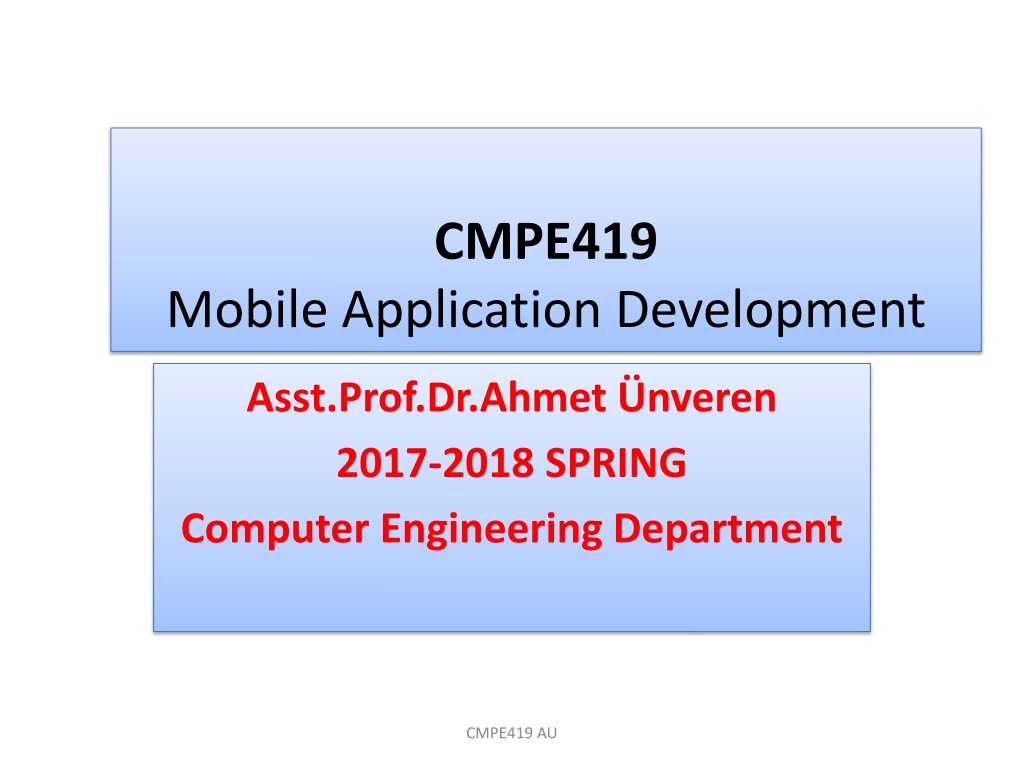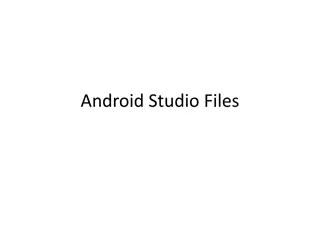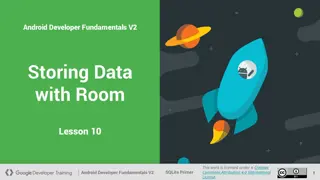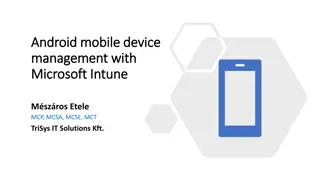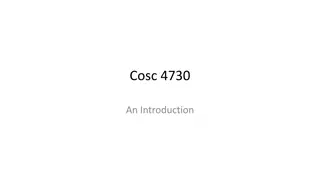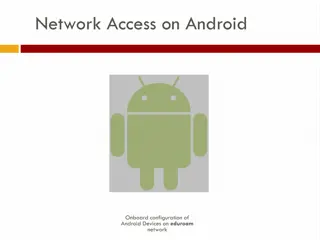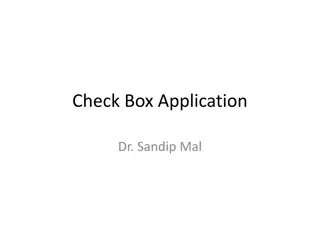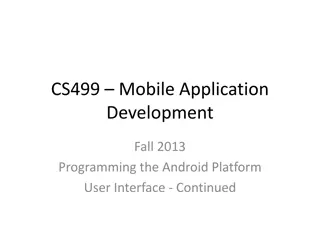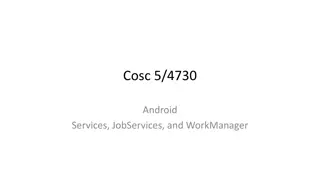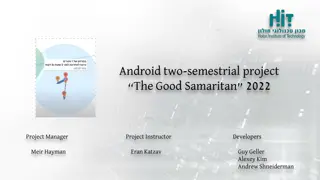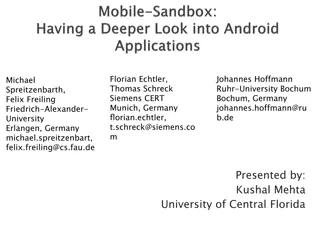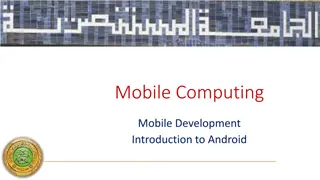Android Application Development Process Overview
Explore the development process of Android applications, including resources, manifests, building and running, and application structure. Learn about Android SDK, Eclipse IDE, Dalvik VM, ADB, and more to create efficient and effective mobile applications.
Download Presentation

Please find below an Image/Link to download the presentation.
The content on the website is provided AS IS for your information and personal use only. It may not be sold, licensed, or shared on other websites without obtaining consent from the author.If you encounter any issues during the download, it is possible that the publisher has removed the file from their server.
You are allowed to download the files provided on this website for personal or commercial use, subject to the condition that they are used lawfully. All files are the property of their respective owners.
The content on the website is provided AS IS for your information and personal use only. It may not be sold, licensed, or shared on other websites without obtaining consent from the author.
E N D
Presentation Transcript
CMPE419 Mobile Application Development Asst.Prof.Dr.Ahmet nveren 2017-2018 SPRING Computer Engineering Department CMPE419 AU
Android Application Development Android SDK Eclipse IDE Android Mobile Device Android Emulator CMPE419 AU
Android development Java Source Android Manifest Generated Class Java .dex File Dalvik VM Compiler Resource XML Android Libraries CMPE419 AU
Development process for an Android app CMPE419 AU http://developer.android.com/guide/developing/index.html
Building and running Compiled resources (xml files) Android Debug Bridge ADB is a client server program that connects clients on developer machine to devices/emulators to facilitate development. An IDE like Eclipse handles this entire process for you. http://developer.android.com/guide/developing/building/index.html#detailed-build CMPE419 AU
Android Manifest Identify user permissions application requires Declare minimum API Level (Minimum android version) Declare hardware and software features required Camera Bluetooth Multi touch screen API Libraries application needs Google Maps Declare components of the application Declare component capabilities CMPE419 AU
Outline What is a resource? Declaration of a resource Resource type: integer, string, array Resource type: color, dimension, style Resource type: drawable, raw, xml Defining Configuration-specific resources Providing the Best resources for a device CMPE419 AU
Application Resources Definition An Application is composed of: code and resources. DEF. Resources are everything that is not code (including: XML layout files, language packs, images, audio/video files, etc) Utilization of Resources why? Separate data presentation (layout) from data management Provide alternative resources to support specific device configurations (e.g. different language packs) Re-compile only when strictly needed! CMPE419 AU
Application Resources Definition PROBLEM. An Android application might run on heterogenous devices with different characteristics (e.g. screen size, language support, keyboard type, input devices, etc). 11,868 different devices in 2014! CMPE419 AU
Application Resources Definition The same application layout with 8 buttons, on a tablet and on a smartphone (Nexus 7) device. CMPE419 AU
Application Resources Definition PROBLEM. An Android application might run on heterogenous devices with different characteristics (e.g. screen size, language support, keyboard type, input devices, etc). TRADITIONAL SOLUTION. Foresee all the alternatives in Java code The code is full of if-else cases Recompile when need to change layout or add a new language package. ANDROID SOLUTION. Separate code from application resources Use declerative XML-based approch to define resources (images, files, layout, text, etc) CMPE419 AU
Application Resources Definition Use XML files to define (declarative approach): - Application Layout - Text used in the applications - Application Menu - Animations - Java App Code XML Layout File Device 1,2 - Foresee different resources alternatives for different device configurations (e.g. screen resolution, language, input devices. etc) XML String File Italian, English, French XML Animation File .. Resources CMPE419 AU
Application Resources Definition EXAMPLE - Build the application layout through XML files (like HTML) Define two different XML layouts for two different devices At runtime, Android detects the current device configuration and loads the appropriate resources for the application No need to recompile! Just add a new XML file if you need to support a new device - Device 1 HIGH screen pixel density Device 2 LOW screen pixel density - Java App Code - - XML Layout File Device 1 XML Layout File Device 2 CMPE419 AU
Application Resources Definition The same application layout with 8 buttons, on a tablet and on a smartphone (Nexus 7) device. LAYOUT SMARTPHONE LAYOUT TABLET CMPE419 AU
Resources are defined in the res/ folder of the project. Application Resources Definition MyProject src MyActivity.java (Source Code Java) res layout main.xml (Application XML Layout) strings.xml values (Application Labels) drawable icon.png (Application Icons) CMPE419 AU
Application Resources Definition Resource Type Resource contained res/animator XML files that define property animations. res/anim XML files that define tween animations. res/color XML files that define a state list of colors. res/drawable Bitmap files (.png, .9.png, .jpg, .gif) or XML files that are compiled into other resources. res/layout XML files that define a user interface layout. res/menu XML files that define application menus. res/raw Arbitrary files to save in their raw form. res/values XML files that contain simple values, such as strings, integers, array. res/xml Arbitrary XML files. CMPE419 AU
Application Resources Definition Resources are defined in a declarative way through XML. Each resource has a name/identifier (see details later). Example: string.xml contains all the text that the application uses. For example, the name of buttons, labels. default text, etc Resource type (string) <?xml version="1.0" encoding="utf-8"?> <resources> <string name="hello > Hello world! </string> <string name="labelButton"> Insert your username </string> </resources> CMPE419 AU
Application Resources Definition Resource can be accessed in the Java code through the R class, that works as a glue between the world of java and the world of resources. Automatically generated file, no need to modify it. Recreated in case of changes in the res/ directory. public final class R { public static final class string { public static final int hello=0x7f040001; public static final int label1=0x7f040005; } } R contains resource IDs for all the resources in the res/ directory. CMPE419 AU
Application Resources Definition Resources can be accessed from Java code by using the R class and methods of the Activity class (details later). We just need to know the resource Identifier (ID) how to know it? (see next slides) final String hello=getResources().getString(R.string.hello); final String label=getResources().getString(R.string.labelButton); Log.i(STRING_TAG, String1 + hello); Log.i(STRING_TAG, String2 + label); CMPE419 AU
Application Resources Definition STEP0: Declare resources in res/ STEP2: Access resources through R class public final class R { public static final class string { public static final int hello=0x7f040001; public static final int label1=0x7f040005; } <?xml version="1.0" encoding="utf-8"?> <resources> <string name="hello > Hello </string> <string name="label1"> Label </string> </resources> } XML-Based, Declarative Approach Java Code, Programmatic Approach STEP1: Compile the project CMPE419 AU
Access to Application Resources Each Resource is associated with an Identifier (ID), that is composed of two parts: The resource type: Each resource is grouped into a "type, (e.g. string, color, menu, drawable, layout, etc) The resource name, which is either: the filename, excluding the extension; or the value in the XML <android:name> attribute. Identifiers must be unique!! Two ways to access resources: From the Java Code From the XML files CMPE419 AU
Access to Application Resources: XML @[<package_name>:]<resource_type>/<resource_name> <package_name> is the name of the package in which the resource is located (not required when referencing resources from the same package) <resource_type> is the the name of the resource type <resource_name> is either the resource filename without the extension or the android:name attribute value in the XML element. CMPE419 AU
Access to Application Resources: XML <?xml version="1.0" encoding="utf-8"?> <resources> <color name="opaque_red">#f00</color> <string name= labelButton > Submit </string> <string name= labelText > Hello world! </string> </resources> STRING.XML <?xml version="1.0" encoding="utf-8"?> <resources> <Textview android:id= @+id/label1 android:text= @string/labelText android:textcolor= @color/opaque_red > </Textview> <Button android:id= @+id/button1 android:text= @string/labelButton > </Button> </resources> MAIN.XML CMPE419 AU
Access to Application Resources: Java [<package_name>.]R.<resource_type>.<resource_name> <package_name> is the name of the package in which the resource is located (not required when referencing resources from the same package) <resource_type> is the R subclass for the resource type <resource_name> is either the resource filename without the extension or the android:name attribute value in the XML element. CMPE419 AU
Access to Application Resources: Java // Get a string resource from the string.xml file final String hello=getResources().getString(R.string.hello); // Get a color resource from the string.xml file final int color=getResources().getColor(R.color.opaque_red); // Load a custom layout for the current screen setContentView(R.layout.main_screen); // Set the text on a TextView object using a resource ID TextView msgTextView = (TextView) findViewById(R.id.label1); msgTextView.setText(R.string.labelText); CMPE419 AU
Resources Types: string and array Resource Type File Java constant XML tag Description string Any file in the res/values/ R.string.<key> <string> String value associated to a key. integer Any file in the res/values/ R.integer.<key> <integer> Integer value associated to a key. array Any file in the res/values/ R.array.<key> <string-array> <item> <item> </string-array> Array of strings. Each element is a described by an <item> CMPE419 AU
Resources Types: string and array <?xml version="1.0" encoding="utf-8"?> <resources> MYVALUES.XML <string name= app_title > Example Application </string> <string name= label > Hello world! </string> <integer name= val > 53 </integer> <string-array name= nameArray > <item> John </item> <item> Michael </item> </string-array> <integer-array name= valArray > <item> 1 </item> <item> 2 </item> </integer-array> </resources> CMPE419 AU
Resources Types: string and array MYFILE.JAVA // Access the string value final String hello=getResources().getString(R.string.app_title); // Access the string-array values final string[] nameS=getResources().getStringArray (R.array.nameArray); // Access the integer-array values final int[] val=getResources().getIntArray(R.array.valArray); CMPE419 AU
Resources Types: string and array Resources can be defined in the res/string.xml or in anyother file defined by the users (File New Android XML File) CMPE419 AU
Resources Types: string and array Android XML Files can be edited by hand or through the Android plugin (recommended). CMPE419 AU
Other Resources Types Some other resources types (we will meet later ) Resource Type File Java constant XML tag Description layout Any file in the res/layout/ R.layout.<key> <layout> Defines a layout of the screen animation Any file in the res/animator/ R.animator. <key> <animator> Defines a property animation (not the only method!) menu Any file in the res/menu/ R.menu.<key> <menu> User-defined menus with multiple options CMPE419 AU
Resources Types: color, dimension, style Resource Type File Java constant XML tag Description color Any file in the res/values/ R.color.<key> <color> Definition of colors used in the GUI dimension Any file in the res/values/ R.dimen.<key> <dimen> Dimension units of the GUI components style/theme Any file in the res/values/ R.style.<key> <style> Themes and styles used by applications or by components CMPE419 AU
Resources Types: color, dimension, style <?xml version="1.0" encoding="utf-8"?> <resources> STYLES.XML </resources> <color name= red > #FF0000 </color> <color name= red_trasparent > #66DDCCDD</color> Color values can be defined based on one of these syntax rules: #RGB, #ARGB, #RRGGBB, #AARRGGBB (R=red, G=green, B=blue, A=transparency). From Java code: int redTransparent=getResources.getColor(R.color.red_transparent) CMPE419 AU
Resources Types: color, dimension, style Code Description px Pixel units in Inch units mm Millimeter units pt Points of 1/72 inch dp Abstract unit, independent from pixel density of a display sp Abstract unit, independent from pixel density of a display (font) These units are relative to a 160 dpi (dots per inch) screen, on which 1dp is roughly equal to 1px. When running on a higher density screen, the number of pixels used to draw 1dp is scaled up by a factor appropriate for the screen's dpi. Likewise, when on a lower density screen, the number of pixels used for 1dp is scaled down CMPE419 AU
Resources Types: color, dimension, style <?xml version="1.0" encoding="utf-8"?> <resources> MYVALUES.XML <dimen name="textview_height">25dp</dimen> <dimen name="textview_width">150dp</dimen> <dimen name="font_size">16sp</dimen> </resources> Applying dimensions to attributes in the XML layout: <TextView android:layout_height="@dimen/textview_height" android:layout_width="@dimen/textview_width" android:textSize="@dimen/font_size"/> MAIN.XML CMPE419 AU
Resources Types: color, dimension, style <?xml version="1.0" encoding="utf-8"?> <resources> MYVALUES.XML <dimen name="textview_height">25dp</dimen> <dimen name="textview_width">150dp</dimen> <dimen name="font_size">16sp</dimen> </resources> Applying dimensions to attributes in the XML layout: <TextView android:layout_height="@dimen/textview_height" android:layout_width="@dimen/textview_width" android:textSize="@dimen/font_size"/> MAIN.XML CMPE419 AU
Resources Types: color, dimension, style A Style is a set of attributes that can be applied to a specific component of the GUI (View) or to the whole screen or application (in this case, it is also referred as theme ). A style is an XML resource that is referenced using the value provided in the name attribute. Styles can be organized in a hierarchical structure. A style can inherit properties from another style, through the parent attribute. Use <style></style> tags to define a style in the res/ folder. Use <item> to define the attributes of the style. CMPE419 AU
Resources Types: color, dimension, style <?xml version="1.0" encoding="utf-8"?> <resources> <style name="CustomText" parent="@style/Text"> <item name="android:textSize">20sp</item> <item name="android:textColor">#008</item> </style> </resources> MYVALUES.XML Applying a style to a View in the XML layout: <EditText style="@style/CustomText" android:layout_width="fill_parent" android:layout_height="wrap_content" android:text="Hello, World!" /> MAIN.XML CMPE419 AU
Resources Types: drawable Resource Type File Java constant XML tag Description drawable Any file in the res/drawable/ R.drawable. <key> <drawable> Images and everything that can be drawn A Drawable resource is a general concept for a graphic that can be drawn on the screen: Images XML resources with attributes such as android:drawable and android:icon (e.g. a Button can have a drawable resource as background) Complete list of drawable resource type can be found here: http://developer.android.com/guide/topics/resources/drawable-resource.html CMPE419 AU
Resources Types: drawable A BitMap file is a .png, .jpg or a .gif file. Android creates a BitMap resource for any of these files saved in the res/drawable directory. This layout XML applies the file myimage.png saved in res/drawable to a View. <ImageView android:layout_width="fill_parent" android:layout_height="wrap_content" android:src= drawable/myimage" /> Retrieve the image as a Drawable from Java: Drawable draw=res.getDrawable(R.drawable.myimage); CMPE419 AU
Resources Types: drawable An XMLBitmap is an XML resource that points to a bitmap file. Usage: (i) Alias to the raw bitmap file, (ii) Specifiy additional properties such as dithering and tiling. <?xml version="1.0" encoding="utf-8"?> <bitmap xmlns:andoid=http://schemas.android.com/apk/res/android andoid:src= @drawable/tile andoid:tileMode= repeat > Some properties of an XMLBitmap: android:src, android:antialias, android:dither, android:filter, android:gravity CMPE419 AU
Resources Types: drawable Drawable type Description BitMap File A bitMap Graphic file (.png, .gif. .jpeg) Nine-Patch File A PNG file with stretchable regions to allow resizing Layer List A Drawable managing an array of other drawable State List A Drawable that references different graphis based on the states Level List An XML managing alternate Drawables. Each assigned a value Transition A Drawable that can cross-fade between two Drawable Inset A Drawable that insets another Drawable by a specific distance A Drawable that clips another Drawable based on its current level Complete list of drawable resource type can be found here: http://developer.android.com/guide/topics/resources/drawable -resource.html Clip Scale A Drawable that changes the size of another Drawable Shape An XML file that defines a geometric shape, colors and gradients CMPE419 AU
Resources Types: xml and raw Resource Type File Java constant XML tag Description xml Any file in the res/xml/ R.xml.<key> <xml> User-specific XML file with name equal to key raw Any file in the res/raw/ R.raw.<key> <raw> Raw resources, accessible through the R class but not optimized Used to define resources for which no run-time optimization must be performed (e.g. audio/video files). They can be accessed an a stream of bytes, by using Java InputStream objects: InputStream is= getResources().openRawResource(R.raw.videoFile) CMPE419 AU
Resources Types: xml and raw The res/xml folder might contain arbitrary XML files that can be read at runtime through the R.xml.<filename> constant. It is possible to parse the XML file through a XMLResourceParser object, that implements an XML parser: XMLResourceParser parser=getResources().getXML(R.xml.myfile) <?xml version="1.0" encoding="utf-8"?> <names> <name code= 1234 >Marco Di Felice </item> <name code=4324">Luca Bedogni </item> </names> CMPE419 AU
Resources Alternatives Android applications might provide alternative resources to support specific device configurations (e.g. different languages). At runtime, Android detects the current device configuration and loads the appropriate resources for the application. To specify configuration-specific alternatives: 1. Create a new directory in res/ named in the form <resources_name>-<config_qualifier> 2. Save the respective alternative resources in this new directory CMPE419 AU
Resources Alternatives Name of the folder: <resources_name>- <config_qualifier>. <resources_name> is the directory name of the corresponding default resources (see previous slides). <qualifier> is a name that specifies an individual configuration for which these resources are to be used (see next slide). res values-it Values for the IT locale values-en Values for the EN locale CMPE419 AU
Resources Alternatives: Qualifiers Configuration Values Example Description mcc310, mcc208, etc MCC and MNC mobile country code (MCC) en, fr, en-rUS, etc Language and region ISO 639-1 language code sw320dp, etc smallestWidth shortest dimension of screen w720dp, w320dp, etc minimum available screen width Available width h720dp, etc Available height minimum available screen height small, normal, large Screen size screen size expressed in dp long, notlong Screen aspect aspect ratio of the screen port, land Screen orientation screen orientation (can change!) ldpi, mdpi, hdpi Screen pixel density (dpi) screen pixel density keysexposed, etc Keyboard availability type of keyword Primary text input method nokeys, qwerty availability of qwerty keyboard navexposed, etc Navigation key availability navigation keys of the application v3, v4, v7, etc Platform Version (API API supported by the device CMPE419 AU level)
Resources Alternatives Android applications might provide alternative resources to support specific device configurations (e.g. different languages). At runtime, Android detects the current device configuration and loads the appropriate resources for the application. To specify configuration-specific alternatives: 1. Create a new directory in res/ named in the form <resources_name>-<config_qualifier> 2. Save the respective alternative resources in this new directory CMPE419 AU
Resources Alternatives Matching When the application requests a resource for which there are multiple alternatives, Android selects which alternative resource to use at runtime, depending on the current device configuration, through the algorithm shown in the Figure. CMPE419 AU
Resources Alternatives Matching DEVICE CONFIGURATION Locale = it Screen orientation = port Screen pixel density = hdpi Touchscreen type = notouch Primary text input method = 12key drawable/ drawable-it/ drawable-fr-rCA/ drawable-it-port/ drawable-it-notouch-12key/ drawable-port-ldpi/ drawable-port-notouch-12key/ CMPE419 AU
